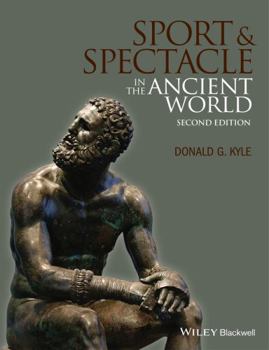Sport and Spectacle in the Ancient World
Select Format
Select Condition 
Book Overview
The second edition of Sport and Spectacle in the Ancient World updates Donald G. Kyle's award-winning introduction to this topic, covering the Ancient Near East up to the late Roman Empire. - Challenges traditional scholarship on sport and spectacle in the Ancient World and debunks claims that there were no sports before the ancient Greeks - Explores the cultural exchange of Greek sport and Roman spectacle and how each culture responded to the other's...
Format:Paperback
Language:English
ISBN:1118613562
ISBN13:9781118613566
Release Date:December 2014
Publisher:Wiley-Blackwell
Length:376 Pages
Weight:1.45 lbs.
Dimensions:0.8" x 7.2" x 9.7"
Related Subjects
Ancient Greece History History of Sports Miscellaneous Rome Sports & Outdoors Sports & RecreationCustomer Reviews
2 ratings
Insightful and fascinating--even scholar's will learn from this
Published by Thriftbooks.com User , 16 years ago
A terrific book, well written and with new insight drawn from archaeology about the use of sport and spectacle in the ancient world. Kyle traces a direct line between the games from the late Bronze age, right up through the end of the gladiatorial contests in the fall of Rome. The Minoans painted frescoes of acrobats and dancers, boxers and people leaping unto bulls--and showed the bulls occasionally goring one of the athletes. The Olympic games brought status and glory to the winning athletes. "Pindar suggests girls and women swooned when a victor returned to Cyrene. Art and poetry show that males swooned too" (p 89). Women were not allowed to attend the games, but maidens were. This tradition was actually for the benefit of the men. "Fathers brought eligible maidens to the male Olympics seeking marriage arrangements (p 227). It was the Romans who would bring games to their horrifying and extravagant peak, with vast sums of money lavished upon exotic beasts, gladiatorial combats, and incredible spectacles of battles. Kyle argues that influences on the games came from many different strands. The Greek games. 'Royal hunts" of imported animals from the Near East. Previously, many historians believes Rome "adapted gladiators from the Etruscans as a form of funerary human sacrifice turned into deadly competition" (p 279), although many scholars today disagree. From Hannibal "Rome encountered the custom of having animals abuse rebels or criminals (p 268). Gladiators, like the winning Greek athletes, became superstars in Rome. "Death and victory were probably the only options for the first gladiators, but later gladiators metrited imiproved chances of survivl" (p 283). Most people today tend to recall the Christians killed in the arena. However, "against the perspective of aggravated executions, the executions of Christians...seem less bizarre...They frustrated and angered crowds by accepting death bravely and calmly in the arena" (p 329). You must have this one!
Insightful and fascinating--even scholar's will learn from this
Published by Thriftbooks.com User , 16 years ago
A terrific book, well written and with new insight drawn from archaeology about the use of sport and spectacle in the ancient world. Kyle traces a direct line between the games from the late Bronze age, right up through the end of the gladiatorial contests in the fall of Rome. The Minoans painted frescoes of acrobats and dancers, boxers and people leaping unto bulls--and showed the bulls occasionally goring one of the athletes. The Olympic games brought status and glory to the winning athletes. "Pindar suggests girls and women swooned when a victor returned to Cyrene. Art and poetry show that males swooned too" (p 89). Women were not allowed to attend the games, but maidens were. This tradition was actually for the benefit of the men. "Fathers brought eligible maidens to the male Olympics seeking marriage arrangements (p 227). It was the Romans who would bring games to their horrifying and extravagant peak, with vast sums of money lavished upon exotic beasts, gladiatorial combats, and incredible spectacles of battles. Kyle argues that influences on the games came from many different strands. The Greek games. 'Royal hunts" of imported animals from the Near East. Previously, many historians believes Rome "adapted gladiators from the Etruscans as a form of funerary human sacrifice turned into deadly competition" (p 279), although many scholars today disagree. From Hannibal "Rome encountered the custom of having animals abuse rebels or criminals (p 268). Gladiators, like the winning Greek athletes, became superstars in Rome. "Death and victory were probably the only options for the first gladiators, but later gladiators metrited imiproved chances of survivl" (p 283). Most people today tend to recall the Christians killed in the arena. However, "against the perspective of aggravated executions, the executions of Christians...seem less bizarre...They frustrated and angered crowds by accepting death bravely and calmly in the arena" (p 329). You must have this one!





